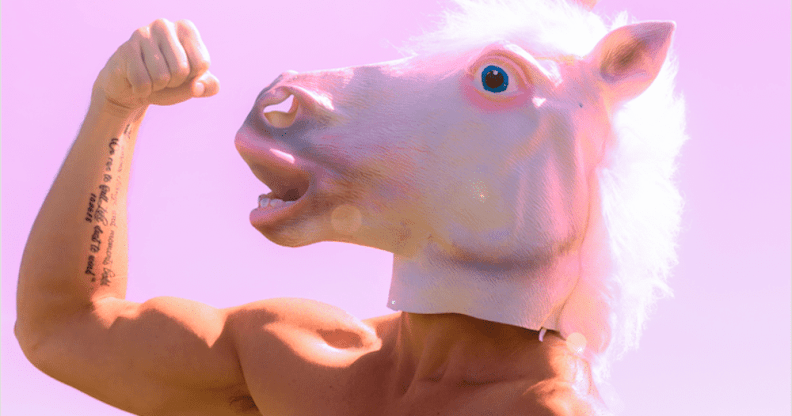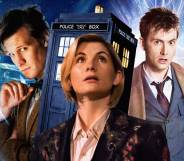Being LGBTQ+ is the most natural thing in the world, new exhibition on ‘queering nature’ shows

Gil Mualem-Doron. (SEAS)
“I don’t go to the countryside, it’s a no-go area,” says Dr Gil Mualem-Doron.
“I love nature, wild nature. Natural reservations, deserts, but no countryside. I feel claustrophobic, I don’t feel comfortable there, because I know that I’m in the minority of the minority of the minority. I mean, I’m ticking the box of at least five minority groups.”
Dr Gil Mualem-Doron is a queer, Arab-Jewish artist and the creative director of Socially Engaged Art Salon (SEAS), a Brighton-based art organisation.
Launched out of Mualem-Doron’s living room in 2016, SEAS’ central aim is to promote the work of queer Black and people of colour (BPOC) artists, especially those with disabilities, migrant refugees and artists from working class backgrounds, all of whom are often excluded from the insular mainstream art world. It’s the only queer BPOC art group in the south east of England.
SEAS not only works with artists from these marginalised groups, showing socially engaged and political art, but also reaches out to those same communities in the south east, in the hope of improving their access to and interaction with art.
The group’s latest exhibition, Queer/in/g Nature, looks at the dichotomy of the natural and artificial, and how nature is often looked at through a western, heteronormative lens.

Photography by Omer Ga’ash. (SEAS)
Mualem-Doron concocted the idea for the exhibition when he was commissioned by Sussex Wildlife Trust to create a piece about the destruction of the kelp forests along the Sussex coast.
While developing the work, he spoke to a friend and fellow artist, who is also a mixed-race trans person, about their experience of swimming on the Sussex coast, and the interview opened up wider questions about the LGBTQ+ community and nature.
Artists exhibiting work in Queer/in/g Nature looked at the idea of queerness as artificial or unnatural, and how LGBTQ+ people negotiate this when interacting with nature.
“There are a few artists who say that for them, to be in nature is to shed any identifiers,” says Mualem-Doron.
“They are not queer or gay or lesbian or trans in nature, they are people in nature. It’s a place to escape from labels, or even from your own identity.
“Because identity, when it’s celebrated, is great, but sometimes it can really make you tired, you know? You’re exhausted because you’re expected to perform your identity… Other artists tried to expose how nature itself is queer.
“The exhibition is, in a way, saying that being LGBTQ+ is the most natural thing there is.”

Queer Rocks by Simon Olmetti. (SEAS)
Discrimination cannot be extricated from the climate crisis
Of course, discussing nature is impossible without confronting the climate crisis, which is likely to have the quickest impact on marginalised communities.
“Any vulnerable communities, and it could be the majority in the global south, or LGBTQ+ people or trans people or women [will be impacted],” says Mualem-Doron.
“We need to remember that the environmental crisis is not only an environmental crisis, it will be affecting everything from the economy to law and order. There will be riots when the food chain collapses, and the first to be attacked will be these communities.
“It sounds like science fiction, if the Gulf Stream is disappearing because of the melting of the ice caps, you can see [this happening] in like 10 years.”
Referencing the UK’s terrifying Nationality and Borders Bill, he continues: “Europe, definitely the UK, is closing its borders, and when there is mass migration of people migrating because of the environment, you will have LGBTQ+ people who even in a normal situation need to escape… these LGBTQ+ people will find it far more difficult.
“It’s already difficult anyhow, but it will be far more difficult to seek refuge because so many other people are seeking refuge.”

Reclamation of the Exposition by Tayo Adekunle. (SEAS)
Mualem-Doron’s own piece, titled Interweaving Spaces, is a large-scale installation which recreates the experience of swimming in a kelp forest, and links the diverse eco systems of the kelp forests to diversity among people.
He explains: “I don’t see environmental issues as separated from issues of wellbeing or issues of diversity… So I was looking about natural diversity and cultural diversity.
The installation has textiles hanging from the ceiling, reimagining the kelp forest, and the prints on the textiles are made by tracing or shapes of kelp.
“I used textiles from communities all over the world that live near kelp forests – African textiles from South Africa and some other countries, textiles from Scandinavia, from Scotland, from north of England, from the States, especially from California and the indigenous tribes there.
“The installation is immersive, so you hear sounds of the sea, and I used the speech of the Barbadian prime minister Mia Mottley at COP26.
“In addition, there will be also a dance by Lya Abdou Issa who’s from an island nation which is already affected by the rising of the sea and the changing climate.”

Gil Mualem-Doron. (SEAS)
SEAS is desperately in search of an arts funding ‘sugar daddy’
SEAS is has been supported by the Art Council England and Brighton and Hove Council since 2018, but the issue of funding always keeps the organisation on edge.
Dr Gil Mualem-Doron says that the group is especially at risk since the Conservative Party’s “levelling up” policy was put into action.
Because of the levelling up agenda, Arts Council funding is being spread out across the country, which Mualem-Doron says is a good thing in theory.
However, as most LGBTQ+ folk gravitate towards cities, it search of community, resources and services, it means that organisations like SEAS are struggling more to access funds.
“We live from one funding application to another,” he explains.
“People keep telling me: ‘You have all of these gay rich people with no kids in Brighton that will donate, that will save you!'”
With a sad laugh, he adds: “I don’t know where these people are. I’m still looking for the sugar daddy for SEAS.”
SEAS’ Queer/in/g Nature exhibition is showing at The Ledward Centre, Brighton’s LGBTQ+ Community and Cultural Centre, from 7 May as part of Brighton Festival.

